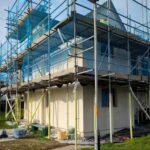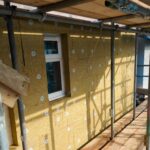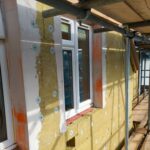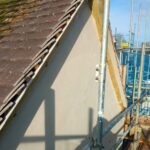In EWI, External Wall Insulation by Robert Wheeler / 9 January 2024 / 0 comments

Insulating existing exterior walls is a topic of growing interest for homeowners looking to enhance the energy efficiency, comfort, and overall performance of their homes. With rising energy costs and a greater emphasis on sustainable living, understanding the feasibility, benefits, and methods of insulating existing exterior walls becomes crucial.
This blog post delves into the process of insulating already constructed walls, exploring various insulation options, assessing the potential savings, and addressing common challenges. Whether you are considering a retrofit project or seeking ways to improve your home’s insulation, this comprehensive guide will provide valuable insights to help you make informed decisions and maximize the benefits of insulating existing exterior walls.
Introduction to insulation of existing exterior walls
The importance of insulation
Insulation is like a cozy sweater for your home. It helps keep the warm air in during the winter and the cool air in during the summer. Not only does insulation make your home more comfortable, but it also plays a major role in energy efficiency and reducing utility bills.
Overview of insulation options
When it comes to insulating existing exterior walls, you’ve got a few options up your sleeve. Internal insulation involves adding insulation material to the inside of your walls, while external insulation does the same on the outside. There’s also injection foam insulation, which fills the gaps in your walls. Each method has its pros and cons, so it’s important to weigh them all before making a decision.
Assessing the feasibility of insulating existing exterior walls
Insulation suitability based on wall construction
Not all walls are created equal when it comes to insulation. The construction of your walls can affect the feasibility of insulation. Solid masonry walls, for example, may be more challenging to insulate compared to cavity walls. Understanding the type of wall construction you have will help determine the best insulation approach.
Evaluating the condition of existing walls
Before diving into insulation, it’s essential to assess the condition of your existing walls. Any signs of dampness or structural issues should be addressed before insulation. It’s like putting on a warm coat over a torn sweater – it won’t be effective if the underlying problems aren’t fixed.
Considering potential obstacles and limitations
Insulating existing exterior walls isn’t always a straightforward process. There may be obstacles to navigate, such as electrical wiring or pipework within the walls. Additionally, some buildings may have restrictions or limitations due to historic or conservation status. It’s important to consider these factors to determine the most suitable insulation method.
Different methods of insulating existing exterior walls
Internal insulation options
Internal insulation involves adding insulation material to the inside of your walls. This method is less invasive and can be a good option for properties with limited exterior access. However, it may slightly reduce the usable floor space and require additional finishing work.
External insulation options
External insulation, as the name suggests, adds insulation material to the outside of your walls. This method can improve energy efficiency and doesn’t affect the usable floor space inside your home. However, it may alter the appearance of your property and could require planning permission in some cases.
Injection foam insulation
Injection foam insulation is like giving your walls a warm hug from the inside. This method involves injecting expanding foam into the wall cavities, filling any gaps. It’s a popular choice for cavity walls and can be a cost-effective solution. However, it may not be suitable for all wall types or where there are existing insulation materials present.
Benefits and considerations of insulating existing exterior walls
Energy efficiency and reduced utility bills
Insulating your exterior walls can significantly improve energy efficiency, meaning you’ll use less energy to heat or cool your home. This can lead to substantial savings on your utility bills in the long run.
Improved indoor comfort and temperature regulation
By insulating your walls, you can say goodbye to those pesky drafts and chilly spots. Insulation helps regulate the temperature inside your home, making it more comfortable throughout the year.
Soundproofing advantages
Insulation not only keeps the temperature in check but can also help reduce noise levels. Whether it’s noisy neighbors or street traffic, insulation can provide an additional layer of soundproofing for your peace and quiet.
Moisture control and prevention of condensation
Insulation can help control moisture levels within your home, reducing the risk of condensation. This is especially important in colder climates where condensation can lead to mould and dampness issues.
Potential impact on property aesthetics
It’s worth considering the impact insulation may have on the look of your home. External insulation, in particular, can alter the appearance of your property. However, with careful planning and the right choice of materials, you can ensure your home remains both cosy and visually appealing.
Step-by-step guide to insulating existing exterior walls
Preparing the walls for insulation
Before you jump right into insulating those exterior walls, there are a few things you need to do to prepare. Start by removing any existing wall coverings, such as wallpaper or panelling. Give the walls a good clean, removing any dirt or debris that might hinder the insulation process. It’s also a good idea to check for any cracks or holes that need to be patched up before moving forward.
Choosing the appropriate insulation material
When it comes to insulation, the options can be overwhelming. From fiberglass to cellulose to spray foam, there’s a material for every preference and budget. Consider factors such as the R-value (the measure of insulation’s effectiveness) and your local climate when making your decision. Don’t be afraid to do some research and consult with professionals to find the best fit for your walls.
Installation techniques and best practices
Now that you have your insulation material of choice, it’s time to get down to business. Depending on the material, there are different installation techniques to follow. For fiberglass batts, you’ll need to measure, cut, and fit the insulation snugly within the walls. Spray foam, on the other hand, requires a bit more finesse, as it expands to fill every nook and cranny. Remember to wear protective gear, as insulation materials can be itchy and messy.
Post-insulation considerations and finishing touches
Congratulations, you’ve successfully insulated your exterior walls! But before you kick back and relax, there are a few final touches to consider. Install a vapor barrier to prevent moisture from seeping into your walls. Don’t forget to seal any gaps or cracks around windows, doors, and electrical outlets to ensure maximum insulation efficiency. And finally, finish off your walls with a fresh coat of paint or new wall coverings to give them a polished look.
Cost implications and potential savings of insulating existing exterior walls
Estimating costs of insulation materials and labour
Let’s talk money, shall we? The cost of insulating existing exterior walls can vary depending on factors such as the size of your space and the insulation material you choose. On average, you can expect to spend anywhere from a few hundred to a few thousand dollars. Keep in mind that hiring professionals to do the job will add to the overall cost, but it might be worth it for the peace of mind and expertise they bring.
Calculating potential energy savings
Okay, so spending money on insulation is one thing, but what’s in it for you in the long run? Well, insulating your exterior walls can significantly reduce your energy bills. By minimizing heat loss in the winter and heat gain in the summer, you can keep your home more comfortable while using less energy. This translates into potential savings of hundreds, if not thousands, of dollars over the years.
Return on investment and long-term financial benefits
Investing in insulation is like giving your home a cosy sweater that pays for itself. While the upfront costs may seem daunting, the return on investment can be substantial. Not only will you see immediate savings on your energy bills, but the improved energy efficiency of your home can also increase its resale value. So, think of insulating your exterior walls as a smart financial move that keeps on giving.
Common challenges and solutions in insulating existing exterior walls
Dealing with hidden structural issues
When it comes to home improvement, surprises are rarely a welcome guest. Before insulating your exterior walls, it’s crucial to inspect them for any hidden structural issues. Moisture damage, rot, or compromised insulation can all pose challenges. If you encounter these issues, it’s best to address them before proceeding with the insulation. Consult with professionals if needed to ensure your walls are in good shape and ready for insulation.
Addressing moisture and ventilation concerns
Moisture and ventilation play a crucial role in maintaining a healthy home. Insulating your exterior walls can affect the natural airflow and potentially trap moisture, leading to mould and other problems. That’s why it’s important to assess your home’s ventilation system and take steps to mitigate any moisture concerns. This might involve adding exhaust fans or installing a balanced ventilation system to ensure adequate airflow and prevent any unwanted moisture build-up.
Minimizing thermal bridging
Thermal bridging, like a sneaky draft under the door, can undermine your insulation efforts. It occurs when there is a break in the insulation barrier, allowing heat to escape or enter through conductive materials. To minimize thermal bridging, pay attention to areas such as corners, studs, and junctions. Add extra insulation or consider using insulation materials that are less prone to thermal bridging. Remember, every little bit of insulation counts in the battle against energy loss.
Is insulating existing exterior walls worth it?
In a world where comfort and energy efficiency are valued more than ever, insulating your existing exterior walls can be a smart move. While it may require some effort and investment upfront, the potential savings on your energy bills and the long-term benefits make it worth considering. Plus, with the right approach and materials, you can tackle common challenges and ensure a successful insulation project. So go ahead, give your walls a warm and cosy makeover – you won’t regret it!
Conclusion
In conclusion, insulating existing exterior walls can bring numerous benefits, including improved energy efficiency, enhanced indoor comfort, soundproofing advantages, moisture control, and potential cost savings. While the process may come with certain challenges and considerations, the long-term advantages outweigh the initial investment. By carefully assessing the feasibility, selecting the appropriate insulation method, and following proper installation techniques, homeowners can significantly upgrade their homes’ insulation and create a more sustainable and comfortable living environment. Investing in the insulation of existing exterior walls is indeed worth it, providing a valuable return on investment and contributing to a greener future.
Insulating Existing Walls FAQs
Yes, it is possible to insulate existing exterior walls without tearing them down. There are various methods available, such as internal insulation, external insulation, or injection foam insulation, which can be applied to the existing walls to enhance insulation without major construction work.
Insulating existing exterior walls can significantly reduce energy bills. Proper insulation helps to minimize heat loss during the winter and prevent heat gain during the summer, leading to improved energy efficiency and reduced reliance on heating and cooling systems. This can result in substantial savings on utility bills over time.
While insulating existing exterior walls offers numerous benefits, there are a few potential drawbacks to consider. It may impact the aesthetics of the property, especially with external insulation methods. Additionally, certain methods may require professional installation or involve upfront costs. It is important to weigh these factors against the long-term advantages before proceeding with insulation.
Ready to discuss your regeneration project and how NXTGEN Futures Ltd can elevate it with expert retrofit? Contact us today!
Latest External Wall Insulation Posts
- What a retrofit-first approach offers the UKRetrofitting is like giving your home a makeover to make it more energy-efficient, comfortable, and healthy. The retrofit-first approach prioritizes upgrading existing buildings over new construction to tackle climate change and improve living conditions. Definition of Retrofitting Retrofitting involves making… Read more: What a retrofit-first approach offers the UK
- What is external wall insulation?External wall insulation (EWI) plays a crucial role in improving the energy efficiency of buildings in the UK, providing numerous benefits such as reduced heat loss, enhanced thermal performance, and increased comfort for occupants. This blog post delves into the… Read more: What is external wall insulation?
- What is retrofitting in construction?Retrofitting in construction is a crucial process that involves upgrading existing buildings or structures to meet modern standards of safety, energy efficiency, and functionality. This blog post explores the concept of retrofitting, its importance, various techniques used in the industry,… Read more: What is retrofitting in construction?
- CASE STUDY: Curtis WayDelivering a Holistic Retrofit Solution with EWI & Solar Energy Project Overview NXTGEN Futures Ltd. successfully completed a large-scale retrofit project on Curtis Way, Berkhamsted, England, UK. This case study showcases our expertise in External Wall Insulation (EWI), retrofit coordination,… Read more: CASE STUDY: Curtis Way
- What happens to a building during retrofitting?Building retrofitting is a vital process that involves making significant modifications and improvements to existing structures to enhance their efficiency, functionality, and sustainability. In this blog post, we will delve into the intricate workings of building retrofitting, exploring the various… Read more: What happens to a building during retrofitting?
- UK Government Retrofit Scheme: Making Energy Efficiency Cool AgainIntroduction to the UK Government Retrofit Scheme Background of the Retrofit Scheme Picture this: you’re sitting at home, snuggled up in your favourite blanket, enjoying a cup of tea, when suddenly you feel a draft. Not cool, right? Well, that’s… Read more: UK Government Retrofit Scheme: Making Energy Efficiency Cool Again
- Project Update: EWI Installation 🏗️We’re excited to announce a major step forward in our External Wall Insulation (EWI) project! Our team has been working diligently to completely wrap the buildings in a new layer of insulation, significantly improving their energy efficiency. Here’s what makes… Read more: Project Update: EWI Installation 🏗️
- What does retrofit include?Retrofitting has become a critical aspect of sustainable building practices, offering opportunities to enhance energy efficiency, improve structural integrity, and prolong the lifespan of existing structures. This blog post delves into the comprehensive process of retrofitting, from the initial assessment… Read more: What does retrofit include?
- Is retrofit insulation worth it?Retrofit insulation refers to the process of adding insulation to existing buildings in order to improve energy efficiency, reduce utility bills, and enhance overall comfort. As energy costs continue to rise and environmental concerns become more prominent, retrofit insulation has… Read more: Is retrofit insulation worth it?
- Can you insulate existing exterior walls?Insulating existing exterior walls is a topic of growing interest for homeowners looking to enhance the energy efficiency, comfort, and overall performance of their homes. With rising energy costs and a greater emphasis on sustainable living, understanding the feasibility, benefits,… Read more: Can you insulate existing exterior walls?
- Is retrofit insulation worth it?When it comes to optimizing energy efficiency in buildings, retrofit insulation has emerged as a valuable solution. Retrofitting insulation involves upgrading or adding insulation to existing structures, offering a range of benefits such as improved energy efficiency, enhanced comfort, and… Read more: Is retrofit insulation worth it?









